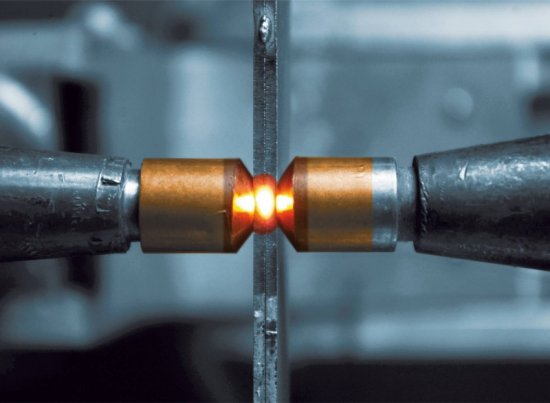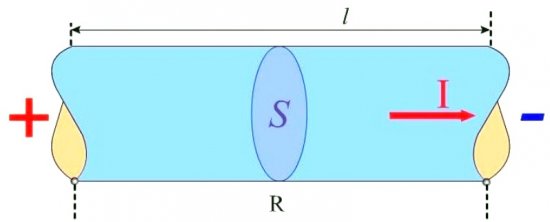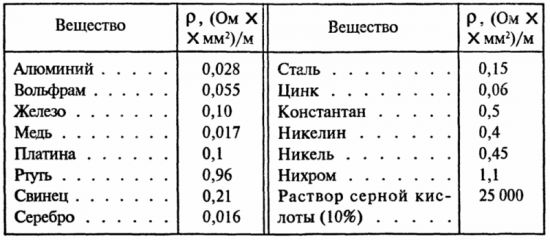Why different materials have different resistance
The amount of current flowing through a wire is directly proportional to the voltage across its ends. This means that the greater the voltage at the ends of a wire, the greater the current in that wire. But for the same voltage on different wires made of different materials, the current will be different. That is, if the voltage on different wires increases in the same way, then the increase in current strength will occur in different wires in different ways, and this depends on the properties of a particular wire.
For each wire, the dependence of the current value on the applied voltage is individual, and this dependence is called electrical resistance of the conductor R… Resistance in general form can be found by the formula R = U / I, that is, as the ratio of the voltage applied to a conductor to the amount of current that occurs at that voltage in that conductor.
The greater the value of current in a wire at a given voltage, the lower its resistance, and the more voltage that must be applied to the wire to produce a given current, the greater the resistance of the wire.
From the formula for finding the resistance, you can express the current I = U / R, this expression is called Ohm's Law… From it it can be seen that the greater the resistance of the wire, the smaller the current.
Resistance, as it were, prevents the flow of current, prevents the electric voltage (electric field in the wire) from creating an even greater current. Thus, resistance characterizes a particular conductor and does not depend on the voltage applied to the conductor. When a higher voltage is applied, the current will be higher, but the ratio U / I, that is, the resistance R, will not change.

In fact, the resistance of a wire depends on the length of the wire, on its cross-sectional area, on the substance of the wire and on its current temperature. The substance of a conductor is related to its electrical resistance through the value of the so-called resistance.
Resistance is what characterizes the material of a conductor, showing how much resistance a conductor made of a given substance will have if such a conductor has a cross-sectional area of 1 square meter and a length of 1 meter. Wires 1 meter long and 1 square meter in cross-section, consisting of different substances, will have different electrical resistances.

The bottom line is that for any substance (usually there are metals, as wires are often made of metals) has its own atomic and molecular structure. Regarding metals, we can talk about the structure of the crystal lattice and the number of free electrons, it is different for different metals. The lower the specific resistance of a given substance, the better the conductor made of it conducts electric current, that is, the better it passes electrons through itself.
Silver, copper and aluminum have low resistivity. Iron and tungsten are much larger, not to mention alloys, the resistance of some of which exceeds pure metals by hundreds of times. The concentration of free charge carriers in wires is significantly higher than in dielectrics, which is why the resistance of wires is always higher.
As noted above, the ability of all substances to conduct current is related to the presence in them of current carriers (charge carriers) — mobile charged particles (electrons, ions) or quasi-particles (for example, holes in a semiconductor) that can move in a given substance over a long distance, we can simply say that we mean that such a particle or quasiparticle must be able to travel in a given substance an arbitrarily large, at least macroscopic, distance.
Since the current density is higher, the greater the concentration of free charge carriers and the higher their average speed of movement, the mobility, which depends on the type of current carrier in a given specific environment, is also important. The greater the mobility of charge carriers, the lower the resistance of this medium.
A longer wire has a higher electrical resistance. After all, the longer the wire, the more ions from the crystal lattice meet in the path of the electrons that form the current. And this means that the more such obstacles the electrons encounter on the way, the more they are slowed down, which means that it decreases current magnitude.
A conductor with a large cross-section gives more freedom to the electrons, as if they were moving not in a narrow tube, but in a wide path. Electrons move more easily in more spacious conditions, forming a current, because they rarely collide with the nodes of the crystal lattice. This is why a thicker wire has less electrical resistance.
As a result, the resistance of a conductor is directly proportional to the length of the conductor, the specific resistance of the substance from which it is made, and inversely proportional to its cross-sectional area. The ultimate resistance formula includes these three parameters.
But there is no temperature in the above formula. Meanwhile, it is known that the resistance of a conductor strongly depends on its temperature. The fact is that the reference value of the resistance of substances is usually measured at a temperature of + 20 ° C. Therefore, here the temperature is still taken into account. There are resistance reference tables for different substance temperatures.
Metals are characterized by an increase in resistance as their temperature increases.
This is because as the temperature rises, the ions of the crystal lattice begin to vibrate more and more and interfere more and more with the movement of the electrons.But in electrolytes, ions carry a charge, therefore, as the temperature of the electrolyte increases, the resistance, on the contrary, decreases, because the dissociation of ions accelerates and they move faster.
In semiconductors and dielectrics, electrical resistance decreases with increasing temperature. This is because the concentration of most charge carriers increases with increasing temperature. The value that accounts for the change in electrical resistance as a function of temperature is called temperature coefficient of resistance.




